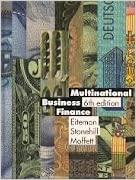Question
1. Reading exercise [10 marks] Read the following stories and indicate whether it is about the investment decision, the financing decision and/or the dividend decision.
1. Reading exercise [10 marks]
Read the following stories and indicate whether it is about the investment decision, the financing decision and/or the dividend decision. Briefly explain your answers. Note: more than one answer is possible in each question.
Story A. Microsoft borrows from investors by issuing $14 billion in ten-year bonds. Proceeds from the deal will be used to help fund Microsofts $26 billion acquisition of LinkedIn, and to pay dividends on ordinary shares. [5 marks]
[INVESTMENT DECISION] [FINANCING DECISION] [DIVIDEND DECISION]
Story B. IKEA, the Swedish furniture maker, is looking to saturate Europe with low-cost hotels. The new brand will be called Moxy. IKEA is investing around $500 million for 50 budget hotels in Europe in the next five years. [5 marks]
[INVESTMENT DECISION] [FINANCING DECISION] [DIVIDEND DECISION]
2. Present value [10 marks]
Without performing any calculation, indicate which of the two investment projects (D or E) has the cash flows with the highest present value (at any positive discount rate). Briefly explain your answer.
Project D
5,000 (Year 1); 4,000 (Year 2); 3,000 (Year 3); 2,000 (Year 4)
Project E
2,000 (Year 1); 3,000 (Year 2); 4,000 (Year 3); 5,000 (Year 4)
3. Price and present value [15 marks]
Suppose a money manager has the opportunity to purchase a financial instrument that promises to pay 500,000 three years from now. She is offered a price of 350,000.
Question 3.1. Should she buy the instrument if she requires an 11% rate of return? Show your workings and briefly explain your answer. [5 marks]
Question 3.2. Suppose now that the money manager is offered the same price (350,000) as in question 3.1, but now the instrument matures four years from now (instead of three years from now). Should she buy it if she still requires an 11% rate of return? Show your workings and briefly explain your answer. [5 marks]
Question 3.3. Now go back to the original situation in Question 3.1: the instrument matures three years from now, and the money manager is still offered a price of 350,000. But having reassessed the risk, she now requires a 15% rate of return. Should she buy the instrument? Show your workings and briefly explain your answer. [5 marks]
4. Time value of money [15 marks]
As the winner of a breakfast cereal competition, you can choose among the following prizes. Rank the payments from the highest to the lowest present value. The discount rate is 5.5%. Show your workings [5 marks per calculation].
a. 20,000 annually during six years, starting one year from now
b. A payment of 50,000 four years from now plus a payment of 85,000 eight years from now
c. 18,500 annually during six years, starting immediately
d. 22,500 annually during six years, starting five years from now
e. 105,000 one year from now
5. Present and future value [10 marks]
An entrepreneur has arrived at a loan agreement with an investor. According to the terms of the agreement, the entrepreneur will pay a fixed sum of 2,500 during the next five years. Having assessed the risks, the investor requires an 8.5% rate of return. Questions:
a. How much money will the investor lend today to the entrepreneur? Show your workings [5 marks]
b. Prove that the investor will earn an 8.5% annual rate of return if he/she does the deal, by comparing the future value of a 5-year fixed-rate deposit at a bank and the future value of the annuity. Show your workings [5 marks]
6. Loan [20 marks]
Fill in the amortization table for a 4 million four-year loan with a 6% annual interest rate [1 mark per cell].
|
| Annual payment | Interest payment | Principal repayment | Total debt repaid | Outstanding debt |
| End of year 1 |
|
|
|
|
|
| End of year 2 |
|
|
|
|
|
| End of year 3 |
|
|
|
|
|
| End of year 4 |
|
|
|
|
|
7. Sharpe ratio [20 marks]
During the booming stock market years between 2013 and 2017, top-ranked asset manager Diana Sauros produced the following percentage rates of return.
Years Rate of return
2017 2.3%
2016 18.0%
2015 2.6%
2014 11.0%
2013 39.1%
Calculate:
a. The average rate of return [5 marks]
b. The standard deviation of the rate of return (use all the observations) [10 marks]
c. The Sharpe ratio [5 marks]
Step by Step Solution
There are 3 Steps involved in it
Step: 1

Get Instant Access to Expert-Tailored Solutions
See step-by-step solutions with expert insights and AI powered tools for academic success
Step: 2

Step: 3

Ace Your Homework with AI
Get the answers you need in no time with our AI-driven, step-by-step assistance
Get Started


